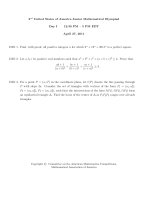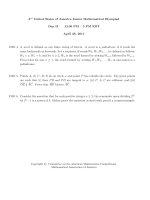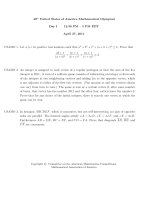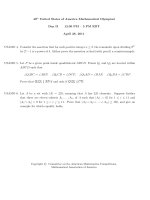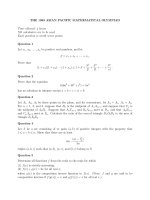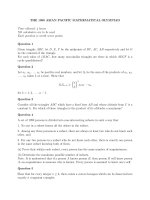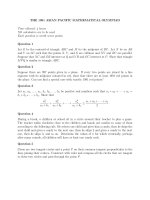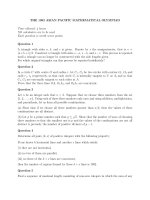ĐỀ THI TOÁN APMO (CHÂU Á THÁI BÌNH DƯƠNG)_ĐỀ 11 ppsx
Bạn đang xem bản rút gọn của tài liệu. Xem và tải ngay bản đầy đủ của tài liệu tại đây (78.08 KB, 1 trang )
XX Asian Pacific Mathematics Olympiad
March, 2008
Time allowed : 4 hours
Each problem is worth 7 points
∗ The contest problems are to be kept confidential until they are posted on the official APMO
website. Please do not disclose nor discuss the problems over the internet until that date. No
calculators are to be used during the contest.
Problem 1. Let ABC be a triangle with ∠A < 60
◦
. Let X and Y be the points on the sides
AB and AC, respectively, such that CA + AX = CB + BX and BA + AY = BC + CY . Let
P be the point in the plane such that the lines P X and P Y are perpendicular to AB and
AC, respectively. Prove that ∠BP C < 120
◦
.
Problem 2. Students in a class form groups each of which contains exactly three members
such that any two distinct groups have at most one member in common. Prove that, when
the class size is 46, there is a set of 10 students in which no group is properly contained.
Problem 3. Let Γ be the circumcircle of a triangle ABC. A circle passing through points
A and C meets the sides BC and BA at D and E, respectively. The lines AD and CE meet
Γ again at G and H, respectively. The tangent lines of Γ at A and C meet the line DE at L
and M, respectively. Prove that the lines LH and MG meet at Γ.
Problem 4. Consider the function f : N
0
→ N
0
, where N
0
is the set of all non-negative
integers, defined by the following conditions :
(i) f(0) = 0, (ii) f(2n) = 2f(n) and (iii) f(2n + 1) = n + 2f(n) for all n ≥ 0.
(a) Determine the three sets L := { n | f(n) < f(n + 1) }, E := { n | f(n) = f(n + 1) }, and
G := { n | f (n) > f(n + 1) }.
(b) For each k ≥ 0, find a formula for a
k
:= max{f(n) : 0 ≤ n ≤ 2
k
} in terms of k.
Problem 5. Let a, b, c be integers satisfying 0 < a < c − 1 and 1 < b < c. For each k,
0 ≤ k ≤ a, let r
k
, 0 ≤ r
k
< c, be the remainder of kb when divided by c. Prove that the two
sets {r
0
, r
1
, r
2
, . . . , r
a
} and {0, 1, 2, . . . , a} are different.


